Deck 43: Sensory Systems
Question
Question
Question
Question
Question
Question
Question
Question
Question
Question
Question
Question
Question
Question
Question
Question
Question
Question
Question
Question
Question
Question
Question
Question
Question
Question
Question
Question
Question
Question
Question
Question
Question
Question
Question
Question
Question
Question
Question
Question
Question
Question
Question
Question
Question
Question
Question
Question
Question
Question
Question
Question
Question
Question
Question
Question
Question
Question
Question
Question
Question
Question
Question
Match between columns
Question
Question
Question
Question
Question
Question
Question
Question
Question
Question
Question
Question
Question
Question
Question

Unlock Deck
Sign up to unlock the cards in this deck!
Unlock Deck
Unlock Deck
1/78
Play
Full screen (f)
Deck 43: Sensory Systems
1
Figure 43-2 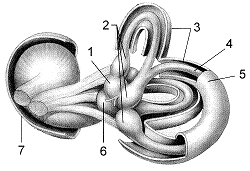 The structures labeled as 3 in the accompanying figure are the:
The structures labeled as 3 in the accompanying figure are the:
A) ampullae.
B) cochleae.
C) utricles.
D) semicircular canals.
E) cochlear nerves.
 The structures labeled as 3 in the accompanying figure are the:
The structures labeled as 3 in the accompanying figure are the:A) ampullae.
B) cochleae.
C) utricles.
D) semicircular canals.
E) cochlear nerves.
D
2
Damage to which type of sensory receptor would lead to an impaired detection of food?
A) mechanoreceptors
B) proprioceptors
C) thermoreceptors
D) exteroceptors
E) interoceptors
A) mechanoreceptors
B) proprioceptors
C) thermoreceptors
D) exteroceptors
E) interoceptors
A
3
Sensory neurons release glutamate and neuropeptides such as ____ to enhance the effect of glutamate.
A) GABA
B) substance P
C) serotonin
D) norepinephrine
E) epinephrine
A) GABA
B) substance P
C) serotonin
D) norepinephrine
E) epinephrine
B
4
Changes in blood pH are detected by:
A) interoceptors.
B) exteroceptors.
C) mechanoreceptors.
D) proprioceptors.
E) thermoreceptors.
A) interoceptors.
B) exteroceptors.
C) mechanoreceptors.
D) proprioceptors.
E) thermoreceptors.

Unlock Deck
Unlock for access to all 78 flashcards in this deck.
Unlock Deck
k this deck
5
Pit vipers and boas locate their prey using:
A) electroreceptors.
B) thermoreceptors.
C) specialized olfactory receptors.
D) ampullae of Lorenzini.
E) lateral line organs.
A) electroreceptors.
B) thermoreceptors.
C) specialized olfactory receptors.
D) ampullae of Lorenzini.
E) lateral line organs.

Unlock Deck
Unlock for access to all 78 flashcards in this deck.
Unlock Deck
k this deck
6
What would happen if you cut the vestibular fibers of the vestibulocochlear nerve?
A) You would not be able to detect sound.
B) You would not be able to detect linear acceleration.
C) You would lose sensory functions in the upper body.
D) You would lose your sense of taste.
E) You would lose your sense of smell.
A) You would not be able to detect sound.
B) You would not be able to detect linear acceleration.
C) You would lose sensory functions in the upper body.
D) You would lose your sense of taste.
E) You would lose your sense of smell.

Unlock Deck
Unlock for access to all 78 flashcards in this deck.
Unlock Deck
k this deck
7
Which of the following correctly describes the order of events that occur when you touch a very hot surface?
1) action potential in sensory neuron
2) sensory receptor absorbs energy from stimulus
3) receptor potential produced
4) stimulus is transduced into electrical energy
A) 1 → 3 → 4 → 2
B) 2 → 1 → 4 → 3
C) 2 → 4 → 3 → 1
D) 4 → 1 → 3 → 2
E) 3 → 1 → 4 → 2
1) action potential in sensory neuron
2) sensory receptor absorbs energy from stimulus
3) receptor potential produced
4) stimulus is transduced into electrical energy
A) 1 → 3 → 4 → 2
B) 2 → 1 → 4 → 3
C) 2 → 4 → 3 → 1
D) 4 → 1 → 3 → 2
E) 3 → 1 → 4 → 2

Unlock Deck
Unlock for access to all 78 flashcards in this deck.
Unlock Deck
k this deck
8
Some species of sharks, rays, and bony fish sense the movement of prey through the use of:
A) electroreceptors.
B) mechanoreceptors.
C) thermoreceptors.
D) interoceptors.
E) nociceptors.
A) electroreceptors.
B) mechanoreceptors.
C) thermoreceptors.
D) interoceptors.
E) nociceptors.

Unlock Deck
Unlock for access to all 78 flashcards in this deck.
Unlock Deck
k this deck
9
To prevent a shipwreck, submarines determine where objects are positioned under water using sonar, sound waves. This method of detection is similar to a(n):
A) snake using thermoreceptors to locate its prey.
B) shark using lateral line receptors to locate its prey.
C) frog using mating calls to locate a female.
D) earthworm being able to determine its position underground using a statocyst.
E) bat using echolocation to hunt prey.
A) snake using thermoreceptors to locate its prey.
B) shark using lateral line receptors to locate its prey.
C) frog using mating calls to locate a female.
D) earthworm being able to determine its position underground using a statocyst.
E) bat using echolocation to hunt prey.

Unlock Deck
Unlock for access to all 78 flashcards in this deck.
Unlock Deck
k this deck
10
Which group of receptors is most important in helping a diver maintain an upright position while exploring a dark passageway in an underwater shipwreck?
A) proprioceptors
B) nociceptors
C) chemoreceptors
D) thermoreceptors
E) electroreceptors
A) proprioceptors
B) nociceptors
C) chemoreceptors
D) thermoreceptors
E) electroreceptors

Unlock Deck
Unlock for access to all 78 flashcards in this deck.
Unlock Deck
k this deck
11
As the result of a genetic mutation, certain strains of mice eat so much that their stomachs burst. Which statement provides the most plausible explanation for why this would happened?
A) The mice were unable to taste the food and therefore, they ate more than a normal amount.
B) The mice were given strong antibiotics that interfered with normal intestinal flora.
C) The mechanoreceptors of the mice's stomachs were either absent or not functioning.
D) The mice were born without proprioceptors.
E) The mice's chemoreceptors did not detect the presence of food in their stomachs.
A) The mice were unable to taste the food and therefore, they ate more than a normal amount.
B) The mice were given strong antibiotics that interfered with normal intestinal flora.
C) The mechanoreceptors of the mice's stomachs were either absent or not functioning.
D) The mice were born without proprioceptors.
E) The mice's chemoreceptors did not detect the presence of food in their stomachs.

Unlock Deck
Unlock for access to all 78 flashcards in this deck.
Unlock Deck
k this deck
12
Some sensory receptors decrease their frequency of action potentials when exposed to a continued, constant stimulus in a process known as:
A) transduction.
B) sensory adaptation.
C) referred perception.
D) reception.
E) sensory summation.
A) transduction.
B) sensory adaptation.
C) referred perception.
D) reception.
E) sensory summation.

Unlock Deck
Unlock for access to all 78 flashcards in this deck.
Unlock Deck
k this deck
13
After working several hours in a flower shop, you do not detect the smell of the roses. Why?
A) Sensory adaptation has occurred.
B) Competing signal transduction pathways have been activated.
C) Sensory perception has been blocked.
D) Sensory summation has occurred.
E) The nasal epithelium has become blocked.
A) Sensory adaptation has occurred.
B) Competing signal transduction pathways have been activated.
C) Sensory perception has been blocked.
D) Sensory summation has occurred.
E) The nasal epithelium has become blocked.

Unlock Deck
Unlock for access to all 78 flashcards in this deck.
Unlock Deck
k this deck
14
What is one characteristic of sensory receptors?
A) Sensory receptors consist of the endings of efferent neurons.
B) Sensory receptors detect changes in the external or internal environment.
C) Several sensory organs make up a sensory receptor.
D) Sensory receptors produce small amounts of energy on a continual basis.
E) Sensory receptors detect changes in the external but not the internal environment.
A) Sensory receptors consist of the endings of efferent neurons.
B) Sensory receptors detect changes in the external or internal environment.
C) Several sensory organs make up a sensory receptor.
D) Sensory receptors produce small amounts of energy on a continual basis.
E) Sensory receptors detect changes in the external but not the internal environment.

Unlock Deck
Unlock for access to all 78 flashcards in this deck.
Unlock Deck
k this deck
15
Bats, by emitting high-pitched sounds, can detect distant objects via:
A) olfaction.
B) echolocation.
C) lateral line organs.
D) sensory adaptation.
E) ommatidia.
A) olfaction.
B) echolocation.
C) lateral line organs.
D) sensory adaptation.
E) ommatidia.

Unlock Deck
Unlock for access to all 78 flashcards in this deck.
Unlock Deck
k this deck
16
Which animal(s) are likely relying on their electromagnetic receptors?
A) A snake attacking its prey
B) A dog smelling a neighbor grilling a steak
C) A mosquito landing on a human's arm
D) A flatworm sensing a flash of light
E) A flock of birds migrating to the Southern Hemisphere
A) A snake attacking its prey
B) A dog smelling a neighbor grilling a steak
C) A mosquito landing on a human's arm
D) A flatworm sensing a flash of light
E) A flock of birds migrating to the Southern Hemisphere

Unlock Deck
Unlock for access to all 78 flashcards in this deck.
Unlock Deck
k this deck
17
Considering that all action potentials are essentially the same, how do we differentiate visual from auditory stimuli?
A) The amplitude of each action potential is specific for different stimuli.
B) The length of time each stimulus takes to travel to the brain varies.
C) Receptor potentials are graded.
D) Each type of sensory receptor transmits to a specific area of the brain.
E) The frequency of action potentials is characteristic of the specific neuron.
A) The amplitude of each action potential is specific for different stimuli.
B) The length of time each stimulus takes to travel to the brain varies.
C) Receptor potentials are graded.
D) Each type of sensory receptor transmits to a specific area of the brain.
E) The frequency of action potentials is characteristic of the specific neuron.

Unlock Deck
Unlock for access to all 78 flashcards in this deck.
Unlock Deck
k this deck
18
Figure 43-2  The structures labeled as 2 in the accompanying figure are the:
The structures labeled as 2 in the accompanying figure are the:
A) ampullae.
B) cochleae.
C) utricles.
D) semicircular canals.
E) bony labyrinth.
 The structures labeled as 2 in the accompanying figure are the:
The structures labeled as 2 in the accompanying figure are the:A) ampullae.
B) cochleae.
C) utricles.
D) semicircular canals.
E) bony labyrinth.

Unlock Deck
Unlock for access to all 78 flashcards in this deck.
Unlock Deck
k this deck
19
The membranous labyrinth of the inner ear consists of the:
A) saccule, utricle, and three semicircular canals.
B) vestibular canal and oval window.
C) cochlea, tympanum, and three bones.
D) statoliths and hair cells.
E) endolymph, perilymph, and the organ of Corti.
A) saccule, utricle, and three semicircular canals.
B) vestibular canal and oval window.
C) cochlea, tympanum, and three bones.
D) statoliths and hair cells.
E) endolymph, perilymph, and the organ of Corti.

Unlock Deck
Unlock for access to all 78 flashcards in this deck.
Unlock Deck
k this deck
20
The ability of the brain to assign meaning to a stimulus is called:
A) adaptation.
B) integration.
C) sensation.
D) perception.
E) assimilation.
A) adaptation.
B) integration.
C) sensation.
D) perception.
E) assimilation.

Unlock Deck
Unlock for access to all 78 flashcards in this deck.
Unlock Deck
k this deck
21
A person can discriminate loud sound from a soft sound because a loud sound:
A) is sent to a different area of the brain than a soft sound.
B) produces a strong graded potential.
C) stimulates a greater number of hair cells.
D) stimulates the hair cells more intensely.
E) has a different vibration frequency than that of a soft sound.
A) is sent to a different area of the brain than a soft sound.
B) produces a strong graded potential.
C) stimulates a greater number of hair cells.
D) stimulates the hair cells more intensely.
E) has a different vibration frequency than that of a soft sound.

Unlock Deck
Unlock for access to all 78 flashcards in this deck.
Unlock Deck
k this deck
22
A sudden loud sound such as an explosion is most likely to impair hearing by damaging which of the following?
A) hair cells in the organ of Corti
B) the vestibular nerve
C) the utricle and saccule
D) the otoliths
E) the endolymph
A) hair cells in the organ of Corti
B) the vestibular nerve
C) the utricle and saccule
D) the otoliths
E) the endolymph

Unlock Deck
Unlock for access to all 78 flashcards in this deck.
Unlock Deck
k this deck
23
When an earthworm is underground, which type of receptors will relay information on directional movement?
A) lateral line organs
B) otoliths
C) cristae
D) stereocilia
E) statocysts
A) lateral line organs
B) otoliths
C) cristae
D) stereocilia
E) statocysts

Unlock Deck
Unlock for access to all 78 flashcards in this deck.
Unlock Deck
k this deck
24
You observe a group of fish turn almost simultaneously in the same direction. Which receptors are they using?
A) lateral line organs
B) otoliths
C) cristae
D) stereocilia
E) statocysts
A) lateral line organs
B) otoliths
C) cristae
D) stereocilia
E) statocysts

Unlock Deck
Unlock for access to all 78 flashcards in this deck.
Unlock Deck
k this deck
25
Which three types of proprioceptors are stimulated when you ride a bicycle?
A) muscle spindles, mechanoreceptors, and thermoreceptors
B) mechanoreceptors, interoceptors, and lateral line organs
C) muscle spindles, Golgi tendon organs, and joint receptors
D) lateral line organs, Golgi tendon organs, and mechanoreceptors
E) interoceptors, joint receptors, and lateral line organs
A) muscle spindles, mechanoreceptors, and thermoreceptors
B) mechanoreceptors, interoceptors, and lateral line organs
C) muscle spindles, Golgi tendon organs, and joint receptors
D) lateral line organs, Golgi tendon organs, and mechanoreceptors
E) interoceptors, joint receptors, and lateral line organs

Unlock Deck
Unlock for access to all 78 flashcards in this deck.
Unlock Deck
k this deck
26
Figure 43-3  In the accompanying figure, the structure labeled as 4 is the:
In the accompanying figure, the structure labeled as 4 is the:
A) basilar membrane.
B) tectorial membrane.
C) organ of Corti.
D) sterociliary membrane.
E) vestibular membrane.
 In the accompanying figure, the structure labeled as 4 is the:
In the accompanying figure, the structure labeled as 4 is the:A) basilar membrane.
B) tectorial membrane.
C) organ of Corti.
D) sterociliary membrane.
E) vestibular membrane.

Unlock Deck
Unlock for access to all 78 flashcards in this deck.
Unlock Deck
k this deck
27
Figure 43-3 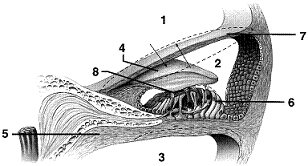 Which portion of the accompanying figure would be connected to the oval window of the cochlea?
Which portion of the accompanying figure would be connected to the oval window of the cochlea?
A) 1
B) 2
C) 3
D) 6
E) 8
 Which portion of the accompanying figure would be connected to the oval window of the cochlea?
Which portion of the accompanying figure would be connected to the oval window of the cochlea?A) 1
B) 2
C) 3
D) 6
E) 8

Unlock Deck
Unlock for access to all 78 flashcards in this deck.
Unlock Deck
k this deck
28
Figure 43-3 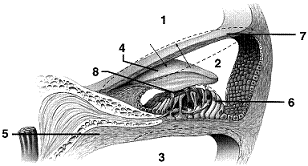 In the accompanying figure, the basilar membrane is labeled as:
In the accompanying figure, the basilar membrane is labeled as:
A) 4.
B) 5.
C) 6.
D) 7.
E) 8.
 In the accompanying figure, the basilar membrane is labeled as:
In the accompanying figure, the basilar membrane is labeled as:A) 4.
B) 5.
C) 6.
D) 7.
E) 8.

Unlock Deck
Unlock for access to all 78 flashcards in this deck.
Unlock Deck
k this deck
29
Figure 43-2  Refer to the accompanying figure. The structures responsible for detecting linear movement relative to the pull of gravity are labeled as ____.
Refer to the accompanying figure. The structures responsible for detecting linear movement relative to the pull of gravity are labeled as ____.
A) 1 and 3
B) 4 and 6
C) 3 and 5
D) 1 and 6
E) 4 and 7
 Refer to the accompanying figure. The structures responsible for detecting linear movement relative to the pull of gravity are labeled as ____.
Refer to the accompanying figure. The structures responsible for detecting linear movement relative to the pull of gravity are labeled as ____.A) 1 and 3
B) 4 and 6
C) 3 and 5
D) 1 and 6
E) 4 and 7

Unlock Deck
Unlock for access to all 78 flashcards in this deck.
Unlock Deck
k this deck
30
Auditory receptors are located in the:
A) cochlea.
B) semicircular canals.
C) utricle.
D) ampullae.
E) otoliths.
A) cochlea.
B) semicircular canals.
C) utricle.
D) ampullae.
E) otoliths.

Unlock Deck
Unlock for access to all 78 flashcards in this deck.
Unlock Deck
k this deck
31
The function of the malleus, incus, and stapes in the middle ear is to:
A) amplify the vibrations of sound waves.
B) cause the organ of Corti to rub against the tectorial membrane.
C) detect movement of the endolymph in the cochlear duct.
D) relieve pressure differences between the middle ear and atmosphere.
E) give support to the membranous labyrinth.
A) amplify the vibrations of sound waves.
B) cause the organ of Corti to rub against the tectorial membrane.
C) detect movement of the endolymph in the cochlear duct.
D) relieve pressure differences between the middle ear and atmosphere.
E) give support to the membranous labyrinth.

Unlock Deck
Unlock for access to all 78 flashcards in this deck.
Unlock Deck
k this deck
32
The brain can infer the pitch of a sound from the:
A) number of hair cells that are stimulated.
B) particular hair cells that are stimulated.
C) intensity with which the hair cells are stimulated.
D) intensity of the action potential produced by the stimulated hair cells.
E) fluid movements of the semicircular canals.
A) number of hair cells that are stimulated.
B) particular hair cells that are stimulated.
C) intensity with which the hair cells are stimulated.
D) intensity of the action potential produced by the stimulated hair cells.
E) fluid movements of the semicircular canals.

Unlock Deck
Unlock for access to all 78 flashcards in this deck.
Unlock Deck
k this deck
33
Which statement concerning gravity detection in humans is true?
A) Statoliths are pulled down by gravity, stimulating hair cells of the statocysts.
B) Otoliths are pulled down by gravity onto stereocilia, stimulating nerve impulses.
C) Gravity moves the cupula, causing hair cells of the lateral line organs to bend.
D) Gravity pulls on the hair cells of the basilar membrane, stimulating nerve impulses.
E) Gravity moves perilymph over the hair cells of the tectorial membrane.
A) Statoliths are pulled down by gravity, stimulating hair cells of the statocysts.
B) Otoliths are pulled down by gravity onto stereocilia, stimulating nerve impulses.
C) Gravity moves the cupula, causing hair cells of the lateral line organs to bend.
D) Gravity pulls on the hair cells of the basilar membrane, stimulating nerve impulses.
E) Gravity moves perilymph over the hair cells of the tectorial membrane.

Unlock Deck
Unlock for access to all 78 flashcards in this deck.
Unlock Deck
k this deck
34
An individual born without Pacinian corpuscles will not :
A) sense stretching of the skin.
B) sense heat from a burning match.
C) feel pain.
D) sense surface vibrations easily.
E) sense heavy pressure quickly.
A) sense stretching of the skin.
B) sense heat from a burning match.
C) feel pain.
D) sense surface vibrations easily.
E) sense heavy pressure quickly.

Unlock Deck
Unlock for access to all 78 flashcards in this deck.
Unlock Deck
k this deck
35
Figure 43-1 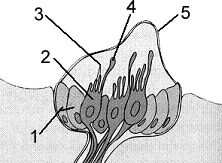 Refer to the accompanying figure with the lateral line organs of fishe s . The structures indicated by label 1 are:
Refer to the accompanying figure with the lateral line organs of fishe s . The structures indicated by label 1 are:
A) hair cells.
B) cupula.
C) stereocilia.
D) sensory neurons.
E) supporting cells.
 Refer to the accompanying figure with the lateral line organs of fishe s . The structures indicated by label 1 are:
Refer to the accompanying figure with the lateral line organs of fishe s . The structures indicated by label 1 are:A) hair cells.
B) cupula.
C) stereocilia.
D) sensory neurons.
E) supporting cells.

Unlock Deck
Unlock for access to all 78 flashcards in this deck.
Unlock Deck
k this deck
36
Figure 43-3 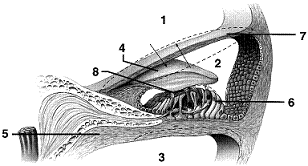 In the accompanying figure, the vestibular canal is labeled as:
In the accompanying figure, the vestibular canal is labeled as:
A) 1
B) 2
C) 3
D) 7
E) 8
 In the accompanying figure, the vestibular canal is labeled as:
In the accompanying figure, the vestibular canal is labeled as:A) 1
B) 2
C) 3
D) 7
E) 8

Unlock Deck
Unlock for access to all 78 flashcards in this deck.
Unlock Deck
k this deck
37
The vestibular canal contains ____, while the cochlear duct contains ____.
A) endolymph; perilymph
B) tympanic membrane; organ of Corti
C) organ of Corti; endolymph
D) perilymph; endolymph
E) scala media; endolymph
A) endolymph; perilymph
B) tympanic membrane; organ of Corti
C) organ of Corti; endolymph
D) perilymph; endolymph
E) scala media; endolymph

Unlock Deck
Unlock for access to all 78 flashcards in this deck.
Unlock Deck
k this deck
38
Which touch receptors of the skin are sensitive to deep pressure?
A) Pacinian corpuscles
B) Meissner corpuscles
C) Merkel disks
D) free nerve endings
E) Ruffini corpuscles
A) Pacinian corpuscles
B) Meissner corpuscles
C) Merkel disks
D) free nerve endings
E) Ruffini corpuscles

Unlock Deck
Unlock for access to all 78 flashcards in this deck.
Unlock Deck
k this deck
39
Sound waves travel within the ear and cause hair cells of the organ of Corti to rub against the ____, initiating nerve impulses to the brain.
A) basement membrane
B) basilar membrane
C) tectorial membrane
D) tympanic membrane
E) plasma membrane
A) basement membrane
B) basilar membrane
C) tectorial membrane
D) tympanic membrane
E) plasma membrane

Unlock Deck
Unlock for access to all 78 flashcards in this deck.
Unlock Deck
k this deck
40
Lateral line organs allow:
A) invertebrates to detect gravity.
B) humans to perform skillful acts with their eyes closed.
C) amphibians to detect light.
D) fish to detect vibrations in water.
E) birds to detect sound waves.
A) invertebrates to detect gravity.
B) humans to perform skillful acts with their eyes closed.
C) amphibians to detect light.
D) fish to detect vibrations in water.
E) birds to detect sound waves.

Unlock Deck
Unlock for access to all 78 flashcards in this deck.
Unlock Deck
k this deck
41
Which receptors are thought to be the most numerous and active in the body?
A) proprioceptors
B) nociceptors
C) chemoreceptors
D) mechanoreceptors
E) electroreceptors
A) proprioceptors
B) nociceptors
C) chemoreceptors
D) mechanoreceptors
E) electroreceptors

Unlock Deck
Unlock for access to all 78 flashcards in this deck.
Unlock Deck
k this deck
42
Figure 43-4 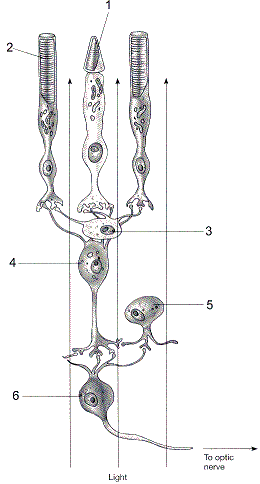 Refer to the accompanying figure. Which label designates a bipolar cell?
Refer to the accompanying figure. Which label designates a bipolar cell?
A) 2
B) 3
C) 4
D) 5
E) 6
 Refer to the accompanying figure. Which label designates a bipolar cell?
Refer to the accompanying figure. Which label designates a bipolar cell?A) 2
B) 3
C) 4
D) 5
E) 6

Unlock Deck
Unlock for access to all 78 flashcards in this deck.
Unlock Deck
k this deck
43
Figure 43-1 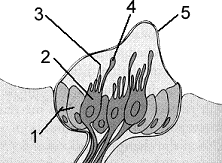 Refer to the accompanying figure with the lateral line organs of fishe s . The structures indicated by label 3 are:
Refer to the accompanying figure with the lateral line organs of fishe s . The structures indicated by label 3 are:
A) hair cells.
B) cupula.
C) stereocilia.
D) sensory neurons.
E) supporting cells.
 Refer to the accompanying figure with the lateral line organs of fishe s . The structures indicated by label 3 are:
Refer to the accompanying figure with the lateral line organs of fishe s . The structures indicated by label 3 are:A) hair cells.
B) cupula.
C) stereocilia.
D) sensory neurons.
E) supporting cells.

Unlock Deck
Unlock for access to all 78 flashcards in this deck.
Unlock Deck
k this deck
44
Figure 43-4 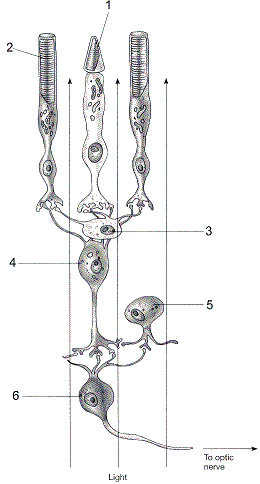 The type of cell labeled as 5 in the accompanying figure is a(n):
The type of cell labeled as 5 in the accompanying figure is a(n):
A) amacrine cell.
B) bipolar cell.
C) ganglion cell.
D) cone.
E) horizontal cell.
 The type of cell labeled as 5 in the accompanying figure is a(n):
The type of cell labeled as 5 in the accompanying figure is a(n):A) amacrine cell.
B) bipolar cell.
C) ganglion cell.
D) cone.
E) horizontal cell.

Unlock Deck
Unlock for access to all 78 flashcards in this deck.
Unlock Deck
k this deck
45
The structure found in the nose of mammals that can detect pheromones is called the ____.
A) pheronasal detector
B) nasopharynx
C) vomeronasal organ
D) olfactory mucosa
E) olfactory receptor ganglia
A) pheronasal detector
B) nasopharynx
C) vomeronasal organ
D) olfactory mucosa
E) olfactory receptor ganglia

Unlock Deck
Unlock for access to all 78 flashcards in this deck.
Unlock Deck
k this deck
46
Chemoreceptors are involved with which two senses?
A) touch and olfaction
B) hearing and olfaction
C) gustation and touch
D) gustation and vision
E) gustation and olfaction
A) touch and olfaction
B) hearing and olfaction
C) gustation and touch
D) gustation and vision
E) gustation and olfaction

Unlock Deck
Unlock for access to all 78 flashcards in this deck.
Unlock Deck
k this deck
47
Cones are responsible for:
A) night vision.
B) the detection of movement.
C) dim light vision.
D) peripheral vision.
E) the perception of fine detail.
A) night vision.
B) the detection of movement.
C) dim light vision.
D) peripheral vision.
E) the perception of fine detail.

Unlock Deck
Unlock for access to all 78 flashcards in this deck.
Unlock Deck
k this deck
48
Figure 43-1  Refer to the accompanying figure with the lateral line organs of fishe s . The structures indicated by label 2 are:
Refer to the accompanying figure with the lateral line organs of fishe s . The structures indicated by label 2 are:
A) hair cells.
B) cupula.
C) stereocilia.
D) sensory neurons.
E) supporting cells.
 Refer to the accompanying figure with the lateral line organs of fishe s . The structures indicated by label 2 are:
Refer to the accompanying figure with the lateral line organs of fishe s . The structures indicated by label 2 are:A) hair cells.
B) cupula.
C) stereocilia.
D) sensory neurons.
E) supporting cells.

Unlock Deck
Unlock for access to all 78 flashcards in this deck.
Unlock Deck
k this deck
49
The structure in the eye that focuses light onto photoreceptors is the ____.
A) sclera
B) pupil
C) iris
D) lens
E) ciliary muscle
A) sclera
B) pupil
C) iris
D) lens
E) ciliary muscle

Unlock Deck
Unlock for access to all 78 flashcards in this deck.
Unlock Deck
k this deck
50
Why are eyespots ineffective at detecting images?
A) Eyespots cannot detect the direction of a light source.
B) Eyespots cannot distinguish light intensity.
C) Eyespots lack sensory cells.
D) Eyespots lack lenses.
E) Eyespots contain opaque lenses.
A) Eyespots cannot detect the direction of a light source.
B) Eyespots cannot distinguish light intensity.
C) Eyespots lack sensory cells.
D) Eyespots lack lenses.
E) Eyespots contain opaque lenses.

Unlock Deck
Unlock for access to all 78 flashcards in this deck.
Unlock Deck
k this deck
51
What is a characteristic of color vision?
A) It is limited to vertebrates.
B) It depends on blue, green, and red cones in primates.
C) It is the result of different concentrations of the photopigment rhodopsin.
D) It results from special photoreceptors located within the optic nerve.
E) It depends on four types of cones in mammals other than primates.
A) It is limited to vertebrates.
B) It depends on blue, green, and red cones in primates.
C) It is the result of different concentrations of the photopigment rhodopsin.
D) It results from special photoreceptors located within the optic nerve.
E) It depends on four types of cones in mammals other than primates.

Unlock Deck
Unlock for access to all 78 flashcards in this deck.
Unlock Deck
k this deck
52
How does rhodopsin facilitate vision?
A) When light strikes rhodopsin, the bipolar cells becomes depolarized, causing the release of GABA.
B) When light strikes rhodopsin, the photoreceptor becomes depolarized, causing the release of GABA.
C) When light strikes rhodopsin, the photoreceptor becomes hyperpolarized, causing the release of GABA.
D) When light strikes rhodopsin, the photoreceptor becomes depolarized, causing the release of glutamate.
E) When light strikes rhodopsin, the photoreceptor becomes hyperpolarized, causing the release of glutamate.
A) When light strikes rhodopsin, the bipolar cells becomes depolarized, causing the release of GABA.
B) When light strikes rhodopsin, the photoreceptor becomes depolarized, causing the release of GABA.
C) When light strikes rhodopsin, the photoreceptor becomes hyperpolarized, causing the release of GABA.
D) When light strikes rhodopsin, the photoreceptor becomes depolarized, causing the release of glutamate.
E) When light strikes rhodopsin, the photoreceptor becomes hyperpolarized, causing the release of glutamate.

Unlock Deck
Unlock for access to all 78 flashcards in this deck.
Unlock Deck
k this deck
53
The opening in the eye through which light passes is known as the ____.
A) sclera
B) pupil
C) iris
D) lens
E) cornea
A) sclera
B) pupil
C) iris
D) lens
E) cornea

Unlock Deck
Unlock for access to all 78 flashcards in this deck.
Unlock Deck
k this deck
54
Two types of eyes that evolved to detect images are the:
A) compound eye of vertebrates and the camera eye of arthropods.
B) compound eye of arthropods and the camera eye of vertebrates.
C) compound eye of vertebrates and the ocelli eye of arthropods.
D) compound eye of arthropods and the ocelli eye of vertebrates.
E) ocelli eye of vertebrates and the camera eye of arthropods.
A) compound eye of vertebrates and the camera eye of arthropods.
B) compound eye of arthropods and the camera eye of vertebrates.
C) compound eye of vertebrates and the ocelli eye of arthropods.
D) compound eye of arthropods and the ocelli eye of vertebrates.
E) ocelli eye of vertebrates and the camera eye of arthropods.

Unlock Deck
Unlock for access to all 78 flashcards in this deck.
Unlock Deck
k this deck
55
Identify the correct order of structures in the vertebrate eye through which incoming light passes before the impulse travels to the brain.
1) aqueous fluid
2) cornea
3) lens
4) optic nerve
5) photoreceptors
6) vitreous body
A) 3 → 6 → 2 → 1 → 5 → 4
B) 1 → 3 → 2 → 6 → 4 → 5
C) 2 → 6 → 3 → 1 → 4 → 5
D) 2 → 1 → 3 → 6 → 5 → 4
E) 3 → 5 → 1 → 6 → 2 → 4
1) aqueous fluid
2) cornea
3) lens
4) optic nerve
5) photoreceptors
6) vitreous body
A) 3 → 6 → 2 → 1 → 5 → 4
B) 1 → 3 → 2 → 6 → 4 → 5
C) 2 → 6 → 3 → 1 → 4 → 5
D) 2 → 1 → 3 → 6 → 5 → 4
E) 3 → 5 → 1 → 6 → 2 → 4

Unlock Deck
Unlock for access to all 78 flashcards in this deck.
Unlock Deck
k this deck
56
What type of signal transduction process is first initiated when an odorant binds with a receptor on a cilium of an olfactory receptor?
A) Ionotropic receptors lead to the synthesis of cyclic AMP.
B) G protein receptors lead to the synthesis of cyclic AMP.
C) Ca2+ gated chloride channels lead to the synthesis of cyclic AMP.
D) Ionotropic receptors lead to the activation of G proteins.
E) Cyclic AMP gated channels lead to the activation of G proteins.
A) Ionotropic receptors lead to the synthesis of cyclic AMP.
B) G protein receptors lead to the synthesis of cyclic AMP.
C) Ca2+ gated chloride channels lead to the synthesis of cyclic AMP.
D) Ionotropic receptors lead to the activation of G proteins.
E) Cyclic AMP gated channels lead to the activation of G proteins.

Unlock Deck
Unlock for access to all 78 flashcards in this deck.
Unlock Deck
k this deck
57
Gina comes home to a sink full of dirty dishes and remarks, "Yuck, what a horrible smell!" She then peels an orange and sighs, "On, that smells much better!" What allows Gina to distinguish between the different smells?
A) Na+ channels are activated for pleasant smells; Cl- channels for unpleasant smells.
B) The process of sensory adaptation differs from smell to smell.
C) The amplitude of an action potential is higher for pleasant smells.
D) The combination of activated receptors differs from smell to smell.
E) Unpleasant smells activate more receptors than pleasant smells.
A) Na+ channels are activated for pleasant smells; Cl- channels for unpleasant smells.
B) The process of sensory adaptation differs from smell to smell.
C) The amplitude of an action potential is higher for pleasant smells.
D) The combination of activated receptors differs from smell to smell.
E) Unpleasant smells activate more receptors than pleasant smells.

Unlock Deck
Unlock for access to all 78 flashcards in this deck.
Unlock Deck
k this deck
58
Each ommatidium of the compound eye of an insect has a biconvex lens and a ____, which help focus light onto photoreceptor cells known as ____.
A) crystalline cone; retinular cells
B) facet; ocelli
C) rhabdome; cones
D) sclera; rods
E) cornea; rhodopsins
A) crystalline cone; retinular cells
B) facet; ocelli
C) rhabdome; cones
D) sclera; rods
E) cornea; rhodopsins

Unlock Deck
Unlock for access to all 78 flashcards in this deck.
Unlock Deck
k this deck
59
For your eye to focus on this sentence, the ciliary muscle would need to:
A) contract for the lens to get rounder.
B) contract for the lens to get flatter.
C) relax for the lens to get rounder.
D) relax for the lens to get flatter.
E) relax to thin out the lens.
A) contract for the lens to get rounder.
B) contract for the lens to get flatter.
C) relax for the lens to get rounder.
D) relax for the lens to get flatter.
E) relax to thin out the lens.

Unlock Deck
Unlock for access to all 78 flashcards in this deck.
Unlock Deck
k this deck
60
In humans, taste buds lie mainly in tiny elevations called ____.
A) stereocilia
B) ommatidia
C) ocelli
D) papillae
E) cilia
A) stereocilia
B) ommatidia
C) ocelli
D) papillae
E) cilia

Unlock Deck
Unlock for access to all 78 flashcards in this deck.
Unlock Deck
k this deck
61
Discuss how a rod responds differently in the light than in the dark.

Unlock Deck
Unlock for access to all 78 flashcards in this deck.
Unlock Deck
k this deck
62
The ciliary muscle changes the shape of the lens.
____________________
____________________

Unlock Deck
Unlock for access to all 78 flashcards in this deck.
Unlock Deck
k this deck
63
Match between columns

Unlock Deck
Unlock for access to all 78 flashcards in this deck.
Unlock Deck
k this deck
64
The retina contains light sensitive cells.
____________________
____________________

Unlock Deck
Unlock for access to all 78 flashcards in this deck.
Unlock Deck
k this deck
65
Compare and contrast the structure and function of the saccule and utricle with that of the semicircular canals with regard to maintaining equilibrium.

Unlock Deck
Unlock for access to all 78 flashcards in this deck.
Unlock Deck
k this deck
66
A(n) interoceptor is located within a body organ.
____________________
____________________

Unlock Deck
Unlock for access to all 78 flashcards in this deck.
Unlock Deck
k this deck
67
Some migratory birds utilize electromagnetic receptors to navigate.
____________________
____________________

Unlock Deck
Unlock for access to all 78 flashcards in this deck.
Unlock Deck
k this deck
68
The outermost covering of the eyeball is the choroid layer .
____________________
____________________

Unlock Deck
Unlock for access to all 78 flashcards in this deck.
Unlock Deck
k this deck
69
Discuss the function of hair cells as sensory receptors, and identify two different locations and/or organs that utilize these receptors.

Unlock Deck
Unlock for access to all 78 flashcards in this deck.
Unlock Deck
k this deck
70
In the visual pathway information is sent from the photoreceptor cells in the retina directly to the ganglion cells.

Unlock Deck
Unlock for access to all 78 flashcards in this deck.
Unlock Deck
k this deck
71
Describe the five main types of connecting neurons in the retina and their functions.

Unlock Deck
Unlock for access to all 78 flashcards in this deck.
Unlock Deck
k this deck
72
Trace the path of a sound wave beginning from its entry into the ear to its transmission to the brain.

Unlock Deck
Unlock for access to all 78 flashcards in this deck.
Unlock Deck
k this deck
73
Meissner corpuscles are sensitive to deep pressure in the skin.
____________________
____________________

Unlock Deck
Unlock for access to all 78 flashcards in this deck.
Unlock Deck
k this deck
74
Explain energy transduction and receptor potential as they relate to the function of a sensory receptor.

Unlock Deck
Unlock for access to all 78 flashcards in this deck.
Unlock Deck
k this deck
75
How does a person distinguish flavors?

Unlock Deck
Unlock for access to all 78 flashcards in this deck.
Unlock Deck
k this deck
76
The vestibular canal and the tympanic canal are filled with endolymph .
____________________
____________________

Unlock Deck
Unlock for access to all 78 flashcards in this deck.
Unlock Deck
k this deck
77
A receptor potential is a(n) all-or-none response.
____________________
____________________

Unlock Deck
Unlock for access to all 78 flashcards in this deck.
Unlock Deck
k this deck
78
Sensilla are sensory hairs involved in taste and smell .
____________________
____________________

Unlock Deck
Unlock for access to all 78 flashcards in this deck.
Unlock Deck
k this deck



